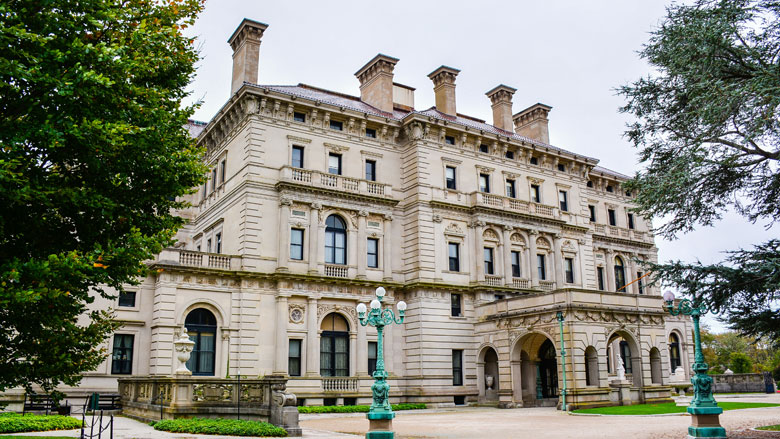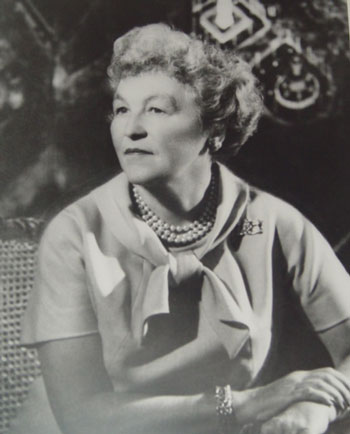The BLOG: Lifestyle
Modern Newport: The city that nearly never was
Diane Kilgore | September 21, 2016

‘The Breakers’, a Vanderbilt Mansion in Newport, R.I. (Adobe Stock photo)
Newport is Boston’s tank-away coastal cousin. It’s a big New England city in the tiny state of Rhode Island and a welcoming home to a cacophony of cultures with a toni-ness of its own.
The nautical metropolis knots historical artifacts to present day pursuits. Relics of a tax-free Gilded Age stand as monuments to life, as some knew it, at the turn of the century. Swashbuckling tales of rum-running in the 1760s salt the air surrounding Truro Synagogue, the oldest surviving temple building in North America as well as God’s Little Acre, America’s Colonial African cemetery, a resting place for souls trapped in the Triangle Trade. Along its shores and rocky cliffs today’s Newport is known as the glamorous sailing capital of the world, however its proud history also anchors this old port to our nation’s steadfast expressions of 1630s colonialism.
Visitors to the city’s charming streets won’t need a compass to bump into history or a hub of current happenings. Newport is saturated with lore, sizzles with culinary creativity and chills with the world’s coolest jazz. Its a rock bed of revolutionizing stories that twist together like dock-line rope. Nearly every corner of the seaside city celebrates spy glasses, sun glasses and cocktail glasses. Newport is a world class destination that challenges its guests to satisfy their curiosities with just one visit.
But for the vision and vitality of an unlikely out-of-towner, a cluster of luster, a commune of coolness, and a treasured trove of colonial architecture would have washed out to sea as post-WWII America was eager to charge into the future by tearing down the past. Alyssa Lozupone, an alum of Newport’s Salve Regina University, outlines the contributions of Katherine Urquhart Warren (1897-1976) in “A Passion for Preservation.” The book of 155 pages was written with the cooperation and support of The Preservation Society of Newport as a part of a post-graduate public policy fellowship in 2013-14 after Louzupone’s graduation from the University of Pennsylvania. In the book the author explains Warren’s path to becoming a doyenne of Newport began in Northern California before she traveled to New Orleans and into the mindset of historians and modern day preservationists nationwide.
Katherine Urquhart was both a devotee of San Francisco’s energetic avant-garde art scene as well as an ingénue with an appreciation for the role her aunt played preserving the history and charms of the South. Informally educated, she was an intellectual amalgam of the richness of her youthful experiences. A July marriage of social and financial un-equals between Katherine and George Henry Warren Jr. raised the gilded eyebrows of Newport’s summer-cottaged residents in 1919. Her charisma and his “rich as Croesus” monied connections wedded the couple to concentric circles of Great Gatsby-style entertainment and influence. It was commonplace for the newlyweds to winter in New York and summer in Newport with his parents. The cottages of The Breakers, Château-sur-Mer, The Elms, Kingscote, Rosecliff, and others became de riguer summer scenery for those living the Americanized version of the Downton Abby life.
Due in large part to the imposition of income and inheritance taxes, the 24-karat glittery life on Newport’s Bellevue Avenue began to tarnish after the turn of the century. In 1932, According to “A Passion for Preservation,” the Jr. Warrens, in an effort to establish independence from his parents, moved with their two young sons to a house on Mill Street. Although the address was considered socially “undesirable,” the family maintained an active schedule entertaining artists, athletes and politicians in their Federal-style home and garden.
The book explains the nexus of Mrs. Warren’s passions and the vibrant city of Newport we treasure today. In 1949 she commissioned Christopher Tunnard, a theorist of modern design to re-landscape her Mill Street garden. Tunnard, the nation’s leading landscape architect of the time, installed Chimerical Font, a sculpture by Jean Arp, now considered to be of national significance. Coupling a love of untraditional art with music, the Warrens were unwilling to hear the protests of conservative peers who feared an invasion of the trés déclassé, as they supported Newport’s first jazz festival in 1954. Tunnard’s affiliation with the Warrens is likely to be what inspired his shift away from modernism as his career morphed into an integrated approach of bonding historic art to architecture.

Katherine Warren, the founder of The Preservation Society of Newport County. (Courtesy of The Preservation Society of Newport County)
The Warrens’ appreciation of modernity and preservation became the elixir of life for the dying city that couldn’t sustain itself without a significant infusion of green to the streets of lost gold. An emotional and financial catalyst to the cause of Newport preservation was the 1963 demolition of beaux arts-styled Penn Station in New York, designed by McKim, Mead and White. The monumental loss of one of the grandest pink-marbled waiting spaces in the world transformed the white-haired woman’s inbred respect for preservation into a plan for sustainable, long-term economic recovery and revival in Newport. Fearing demolition of our nation’s finest examples of colonial, Victorian, mid-eighteenth century and pre-WWII architecture, the Warrens invited their friends to contribute to the area’s deepest reserve of wealth — it’s shared history.
Speaking with the book’s author, Lozupone says Mrs. Warren was comfortable mixing classes with causes. Promotion of her preservation goals led to a modernized, creative approach to conservation. Her signature style of including community members of every neighborhood inspired First Lady Jacqueline Kennedy, tobacco heiress Doris Duke, and others to work together sparking widespread, multi-generational awareness of historic landmarks, advocacy of preservation and fundraising to protect historic heirlooms of all eras from bulldozers. Today Newport is an example of an historically intact city that remains relevant though it’s adaptive re-purposing of provenance.
Devised by Katherine Warren and fellow community activists a philosophical mission statement to preserve Newport was seen as simultaneously traditional and cutting edge in the world of conservation. Abdicating the museum model of Colonial Williamsburg, Virginia and area preservation approach of Charlestown, South Carolina, the plan to save Newport included energetic updates to city planning forging the best values of the old port with modern construction. The like-minded preservationists weren’t interested in saving a few homes or a few streets, their plan was to honor centuries of communal heritage; annexing what’s best about old New England with a commitment to monetize its future. But for the vision of the unlikely out-of-towner, Katherine Warren, Newport’s eclectic history would be lost.
For an expansive list of site-seeing suggestions while visiting Boston’s tank-away coastal cousin, contact: Discover Newport at 1-800-326-6030 or 401-845-9110 or online at www.discovernewport.org. From Sept. 22 to 25, a wine and food festival will be held at three of the Gilded Age mansions.
Contact Diane Kilgore at [email protected].






